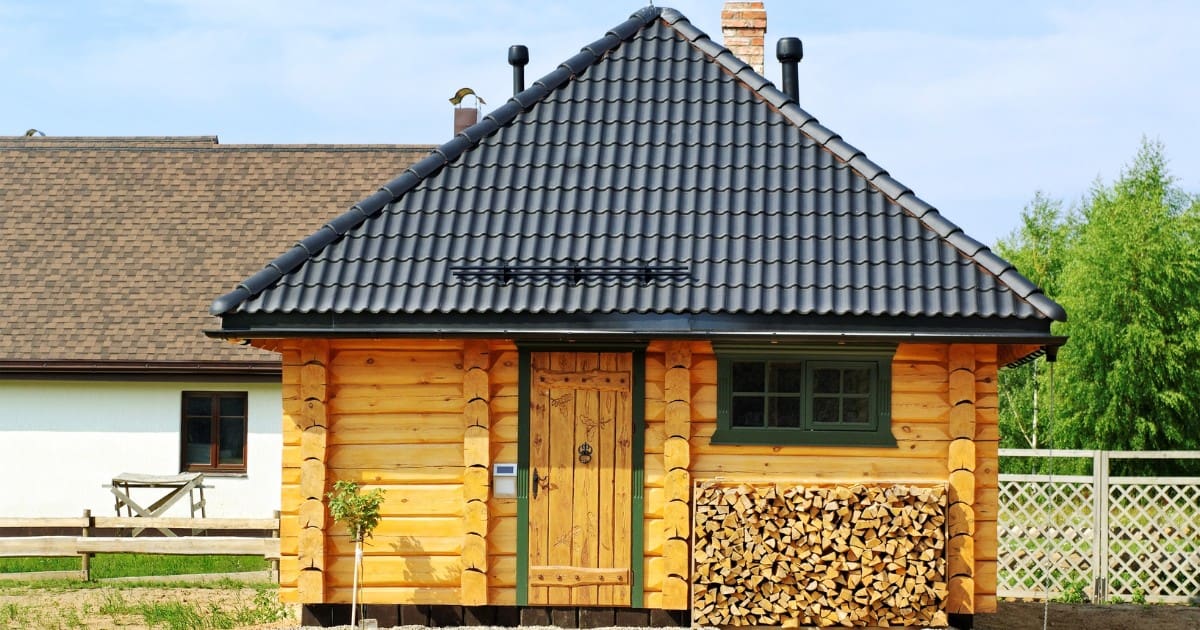Have you ever heard of a Korean sauna? I’m telling you, they’re all the rage these days, not just in South Korea but across the globe. Believe it or not, there are over 4,000 jjimjilbangs (that’s what they call Korean saunas) in South Korea alone! And get this—many of them are open 24/7.
So, what exactly is a Korean sauna, and why are people so obsessed with them? In this ultimate guide, I’ll tell you all the details about jjimjilbangs. We’ll discuss their history, explore the different types of saunas, and I’ll even share some tips on how to make the most of your visit and appreciate the Korean sauna experience.
What Is a Korean Sauna, and Why Is It So Popular?
A Korean sauna, or jjimjilbang, is a public bathhouse that offers a wide range of spa services and facilities. The whole point is relaxation, rejuvenation, and boosting your overall health and well-being. In fact, the word “jjimjilbang” literally translates to “heated rooms”—and trust me, you’ll find plenty of those inside.
Now, you might be wondering why jjimjilbangs have become so insanely popular travel experience in recent years. It’s not just Koreans who are in love with them—international visitors can’t get enough either. Here are a few reasons why:
- Budget-friendly: With entry fees ranging from ₩7,000 to ₩20,000 (that’s about $6 to $17), jjimjilbangs are an affordable treat for everyone.
- Open round-the-clock: Many jjimjilbangs never close, so you can pop in whenever the fancy takes you.
- Loaded with amenities: We’re talking hot and cold baths, saunas galore, steam rooms, relaxation areas, and even entertainment zones.
- A health boost: Korean saunas are known for improving circulation, melting away stress, and helping you catch some quality Zens.
- A social hub: Jjimjilbangs are the perfect spot to hang out with friends and family in a laid-back, relaxing environment.
What is the History of Korean Saunas?

Jjimjilbangs may be all the rage now, but they’re not a new concept. In fact, Korean saunas have been around for centuries, dating all the way back to the Joseon Dynasty in the 15th century.
Back then, a Korean sauna was called hanjeungmak, which translates to “fomentation rooms” or “sickness relief rooms.” As the names suggest, these early saunas were mainly used for medicinal purposes, like treating illnesses and soothing achy muscles.
These original hanjeungmak were typically found in temples and were managed by Buddhist monks. They had separate spaces for men and women and were heated using ondol, a traditional Korean underfloor heating system. Ondol works by transferring heat from wood smoke to the stones that make up the floor. Pretty clever, right?
As time marched on, Korean saunas evolved. By the time the 1990s rolled around, modern jjimjilbangs started cropping up, boasting even more services and amenities. Fast forward to today, and Korean jjimjilbangs have become a cherished part of Korean culture, enjoyed by folks of all ages and backgrounds.
How Does a Korean Jjimjilbang Differ from a Traditional Sauna?
You might be thinking, “Aren’t jjimjilbangs just like regular saunas?” Well, yes and no. While they do share some similarities, there are a few key differences that set jjimjilbangs apart:
| Feature | Jjimjilbangs | Traditional Spas |
|---|---|---|
| Facilities | Saunas, hot tubs, cold baths, steam rooms, entertainment zones | Mainly saunas and hot tubs |
| Gender Segregation | Separate areas for men and women; mixed-gender in common areas | Typically more integrated or entirely segregated spaces |
| Dress Code | T-shirt and shorts provided for common areas | Robe or towel typically provided |
| Access Hours | 24/7, including overnight stays possible | Limited hours, no overnight stays |
| Social Atmosphere | Encourages socializing, great for hanging out with friends | More focused on individual relaxation |
What are the Amenities You Can Expect to Find in a Jjimjilbang?
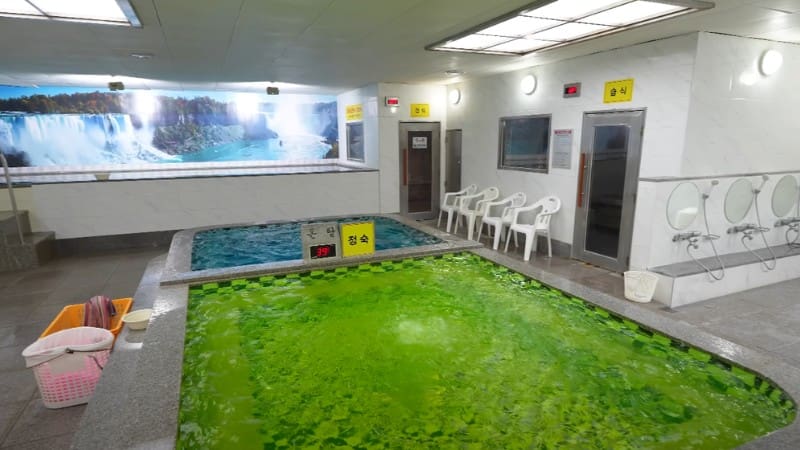
When you step into a jjimjilbang, you’re in for a real treat. These places are packed with all sorts of amenities designed to help you unwind, recharge, and feel your best. Here’s a taste of what you can expect:
| Saunas | Multiple types, each offering unique benefits |
| Hot Tubs | Various temperatures and jet setups |
| Cold Baths | Ideal for cooling down after saunas and boosting the immune system |
| Ice Rooms | Intense cold therapy experience |
| Steam Rooms | Helps open pores and improves breathing |
| Massage Services | Options range from traditional Korean massages to oil massages and foot rubs |
| Sleeping Areas | Communal rooms with floor mats or private sleeping pods |
| Entertainment | Facilities like PC rooms, arcades, and karaoke |
What are the Different Types of Saunas and Their Benefits?
One of the best parts about visiting a jjimjilbang is trying out all the different types of saunas. Korean saunas offers its own unique benefits for your mind and body. Let’s take a look at some of the most common types:
Traditional Korean Sauna (Hanjeungmak)
The OG of Korean saunas, the hanjeungmak, is a dome-shaped room made from clay or stone. It’s heated by a wood-burning stove, and temperatures can soar up to a toasty 80-90°C (176-194°F). It might sound intense, but trust me, it feels amazing.
Benefits:
- Boosts blood circulation
- Eases muscle tension and pain
- Flushes out toxins through some serious sweating
- Gives your immune system a kickstart
Red Clay Sauna (Hwangto-bang)
The hwangto-bang is another popular sauna option, featuring walls and floors made from red clay. This special clay emits far-infrared rays, which are said to work wonders for your health.
Benefits:
- Eliminates toxins by encouraging a good sweat session
- Improves skin health and elasticity
- Relieves joint pain and stiffness
- Revs up your metabolism and aids in weight loss
Charcoal Sauna
As the name suggests, the charcoal sauna is heated with—you guessed it—charcoal. This sauna emits negative ions and infrared rays and usually has a lower temperature than traditional saunas, hovering around 60-70°C (140-158°F).
Benefits:
- Cleans the air and removes harmful toxins
- Promotes relaxation and stress relief
- Enhances respiratory function
- Improves skin health and appearance
A Step-by-Step Guide to Using a Korean Sauna

Alright, now that you know what to expect at a Korean jjimjilbang, let’s walk through how to actually use one. Don’t worry, it’s not as complicated as it might seem!
Step 1 – Arriving and Checking In
When you first arrive at the jjimjilbang, you’ll need to take care of a few things before you can start relaxing.
Store Your Shoes
First things first, you’ll need to take off your shoes and put them in a designated shoe locker. You’ll get a key to keep with you during your stay.
Pay the Entrance Fee and Receiving Your Key and Clothes
After your shoes are squared away, head over to the front desk to pay the entrance fee. It usually ranges from ₩7,000 to ₩20,000 ($6 to $17), depending on the location and time of day.
At the front desk, you’ll receive a key or wristband that corresponds to your locker number. This handy little thing will be your lifeline throughout your jjimjilbang journey. You’ll use it to access your locker and make any purchases inside, like food or drinks.
You’ll also get a set of clothes to wear in the common areas, usually a t-shirt and shorts or some comfy cotton pajamas. Trust me, these are way better than wandering around in a tiny towel or robe.
Step 2 – Getting Ready for the Baths
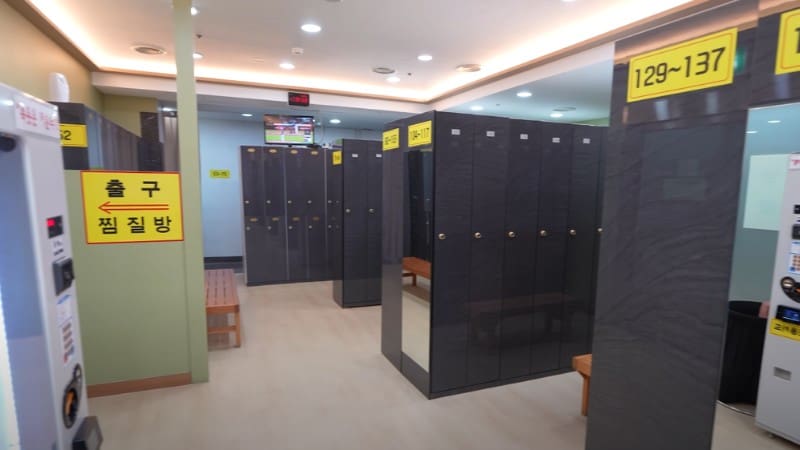
Now that you’ve got your locker key and your snazzy jjimjilbang outfit, it’s time to get ready for the main event: the baths!
Use Your Locker and Change into Jjimjilbang Attire
Head to the gender-segregated locker room. Find your locker using your key or wristband, and then strip down all your suit. Don’t be shy—everyone else will be in the same boat!
Place all your belongings, including your street clothes and underwear, in the locker. Then, slip into the provided jjimjilbang attire.
Bring Essentials to the Bathhouse
Before heading into the bathhouse, grab any essentials you might need:
- A small towel (usually provided by the jjimjilbang)
- Toiletries (shampoo, conditioner, body wash, etc.)
- A hair tie or headband (if you’ve got long locks)
- Flip flops or shower shoes (if you’re not a fan of going barefoot)
The jjimjilbang will usually provide basic toiletries like soap and shampoo, but you might prefer to bring your own. It’s up to you!
Step 3 – Navigate the Baths and Saunas

Alright, it’s time to get down to business. Let’s talk about how to navigate the baths and saunas like a pro.
Shower Before Entering the Pools
Before you even think about dipping your toe into any of the pools or hot tubs, you need to shower thoroughly. This is a non-negotiable rule of Korean bathhouse etiquette, and it helps keep the water clean for everyone.
You’ll see rows of showers with small plastic stools and toiletries. Park yourself on a stool and scrub every nook and cranny of your body, including your hair. Make sure to rinse off all the soap and shampoo before heading to the pools.
Alternate Between Hot and Cold Pools
One of the Korean sauna key principles is alternating between hot and cold experiences. This helps stimulate blood flow, boost your immune system, and promote relaxation.
After spending some time soaking in a hot pool or sweating it out in a sauna, cool off with a dip in a cold pool or a refreshing cold shower.
Then, head back to the hot pool or try out a different Korean sauna. Keep alternating as much as you like, but remember to listen to your body and take breaks when you need to.
Go and Explore the Different Sauna Rooms
As I’ve said earlier, Jjimjilbangs offer several types of saunas, each with its own unique benefits. Take some time to explore the different Korean sauna rooms and find your favorites.
Some saunas, like the red clay or charcoal sauna, might have a slightly lower temperature than the traditional hanjeungmak. These can be a good option if you’re new to saunas or prefer a less intense heat.
Observe Proper Towel Etiquette
When it comes to using Korean sauna towels, there are a few etiquette rules to keep in mind:
- Always sit on your towel when using a sauna or steam room. This helps keep the surfaces clean and hygienic.
- Don’t wear your towel into the pools or hot tubs. Leave it in a designated area or on a hook outside the pool.
- If you need to cover up while walking around the bathhouse, use your small towel to cover your private bits. Don’t use a large towel or your jjimjilbang clothes, as this is considered impolite.
Step 4 – Try Some Additional Spa Treatments (Optional)
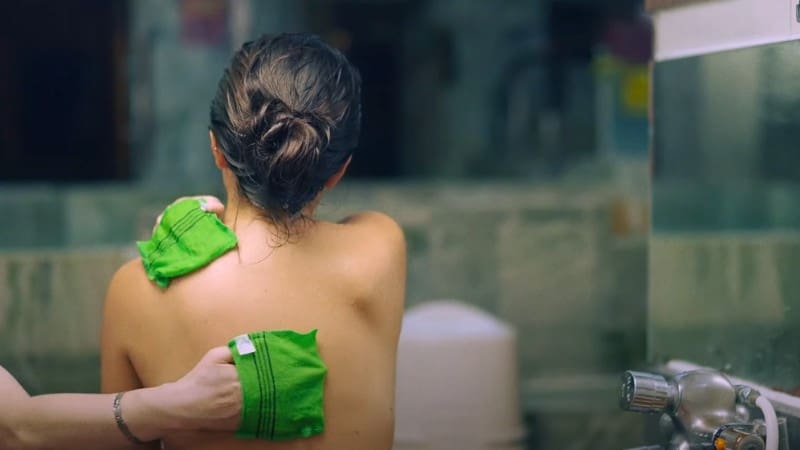
If you’re looking to take your jjimjilbang experience to the next level, many facilities offer additional spa treatments for an extra fee.
Experience a Traditional Body Scrub (Seshin)
One popular treatment is the traditional Korean body scrub, known as seshin. This involves lying on a table while a skilled practitioner (often an older Korean woman called an ajumma) scrubs every inch of your body with exfoliating mitts.
The scrub is usually followed by a full-body massage and a hair wash. The whole process takes about 30-40 minutes and leaves your skin feeling silky smooth and baby-soft.
Unwind with an Oil Massage
Another popular option in a Korean sauna is an oil massage, which involves a full-body massage with aromatic oils. It’s the perfect way to relax and unwind after spending time in the saunas and pools.
These treatments will cost extra, ok? So be sure to check the prices and make a reservation in advance if needed.
Step 5 – Relax in the Common Areas
Once you’ve had your fill of the baths and saunas, it’s time to head to the common areas for some well-deserved relaxation.
Appropriate Attire for Mixed-Gender Spaces
Remember those jjimjilbang clothes you got when you checked in? This is where they come in handy.
In the common areas, you’ll see people wearing the provided t-shirts and shorts or cotton pajamas. Make sure to wear these clothes properly (no tying the shirt up or rolling the shorts too high) to keep things family-friendly and respectful.
Discover Additional Facilities and Amenities
The common areas of a Korean jjimjilbang are where you’ll find most of the extra facilities and amenities, such as:
- Relaxation zones with recliners and floor mats
- Entertainment rooms with TVs, computers, and arcade games
- Restaurants and snack bars
- Outdoor terraces or gardens
- Sleeping areas with floor mats or bunk beds
Take some time to explore these Korean sauna areas and find a cozy spot to unwind. Read a book, catch up on your favorite TV show, chat with friends, or even sneak in a power nap.
Step 6 – Dine and Snack at the Jjimjilbang

Another good thing about spending time at a jjimjilbang is that you don’t have to leave when your stomach starts rumbling. Most Korean sauna facilities have restaurants or snack bars where you can grab a bite without ever changing out of your comfy clothes.
The food options will vary from place to place, but you can usually find a range of tasty Korean dishes like:
| Korean Dish | Description |
|---|---|
| Bibimbap | Colorful rice bowl topped with veggies, meat, and a spicy gochujang sauce |
| Ramyeon | Instant noodles, a quick and easy snack available in various flavors |
| Kimbap | Korean-style sushi rolls |
| Grilled Meats | Includes samgyeopsal (pork belly) and bulgogi (marinated beef) |
| Soups and Stews | Kimchi jjigae (spicy stew with kimchi, pork, and tofu) |
| Sikhye | Sweet rice drink known for aiding digestion |
| Boiled Eggs | Protein-packed snack, sometimes cooked in sauna heat (maekbanseok gyeran) |
| Boricha | Nutty, roasted barley tea, excellent for hydration |
| Instant Ramen | Quick, easy snack noodles in various flavors |
| Bulgogi | Thinly sliced beef in a sweet and savory marinade, grilled to perfection |
| Samgyeopsal | Sizzling pork belly, often wrapped in lettuce with savory sauces |
If you’re lucky, you might stumble upon a South Korean jjimjilbang that offers a unique dining experience. For example, some facilities have special sauna rooms where you can cook your own food using the heat of the sauna.
Other jjimjilbangs might have themed restaurants or cafes with quirky decor and one-of-a-kind menus. And if you’re visiting a jjimjilbang during the warmer months, keep an eye out for outdoor dining areas like terraces or gardens.
To pay for your food and drinks and everything extra, simply use your trusty locker key or wristband. The cost will be added to your total bill, which you’ll settle up when you check out.
Step 7 – Spend the Night at a Korean Sauna (Optional)
I love that many jjimjilbangs are open 24 hours a day, which means we can actually spend the night if we want to. This is a popular option for folks who missed the last train home or just want to make the most of their relaxation time.
Korean Sauna Sleeping Area Options
If you decide to have a sleepover at the jjimjilbang, you’ll find designated sleeping areas that may include:
- Communal sleeping rooms with floor mats and pillows
- Individual sleeping pods or capsules
- Private sleeping rooms (usually for an extra fee)
The sleeping areas are typically separated by gender, so make sure to use the appropriate one.
Nighttime Entertainment at Korean Saunas
Just because it’s time for bed doesn’t mean the fun has to stop. Many jjimjilbangs offer 24-hour entertainment and amenities, such as:
- Movie rooms or TV lounges
- PC rooms or internet cafes
- Karaoke rooms
- 24-hour restaurants or snack bars
And of course, you can always keep using the baths and saunas throughout the night if you’re feeling extra energetic.
Step 8 – Check Out and Depart
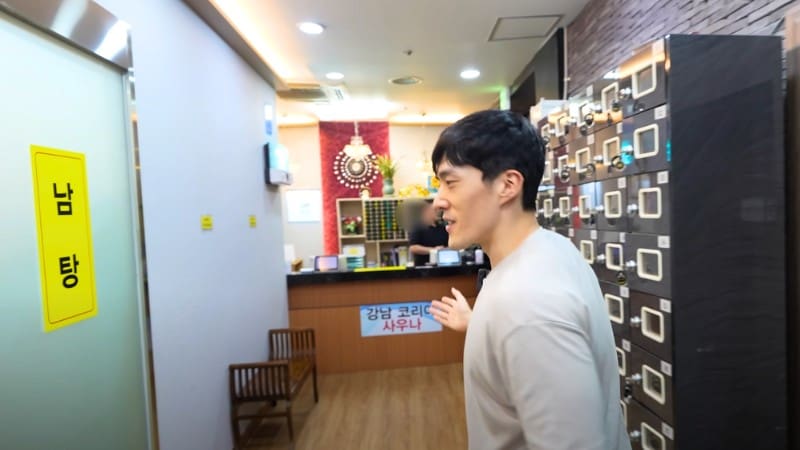
When you’re finally ready to say goodbye to the jjimjilbang in South Korea (or just need to head to your next destination), the check-out process is a breeze.
First, make your way back to the locker room and change into your regular clothes. Gather all your belongings from your locker and return the jjimjilbang clothes.
Next, head to the front desk to settle your bill. If you made any purchases during your stay (like food, drinks, or spa treatments), the cost will be added to your total. You can pay with cash or a credit card.
Finally, don’t forget to grab your shoes from the shoe locker before you head out!
What to Bring (and What’s Provided) When Visiting a Jjimjilbang?
Before you head off to your first (or next) jjimjilbang session, it’s important to know what to pack and what will be waiting for you when you arrive. This will help you avoid overpacking and ensure you have everything you need for a comfortable and enjoyable Korean sauna experience.
Jjimjilbang-Provided Clothing and Accessories
When you arrive at a Korean sauna, you can expect to be provided with the following items:
| Uniform | T-shirt and shorts or cotton pajamas for common areas |
| Towel | Small towel for drying off and covering up in the baths |
| Locker Key/Wristband | Used for accessing your locker and making purchases |
| Toiletries | Includes soap, shampoo, and toothpaste |
| Sandals or Slippers | Provided for use in the common areas |
Take note, these extra items aren’t always a guarantee, so it’s a good idea to bring your own toiletries and footwear just in case.
Essential Personal Items and Toiletries
While the jjimjilbang will provide some basic items, there are a few personal essentials you’ll want to bring along:
| Basic Necessities | Underwear and socks, flip flops/shower shoes |
| Toiletries | Shampoo, conditioner, body wash, face wash, lotion, deodorant |
| Hair Accessories | Hair ties or headbands |
| Hydration | Water bottle |
| Overnight Essentials | Pajamas or comfy clothes, earplugs, eye mask, phone charger |
Pro Tip: Most jjimjilbangs have convenience stores or vending machines where you can grab any last-minute items you might have forgotten.
How Much Does It Cost to Visit a Jjimjilbang and What Are the Extra Expenses?
You’ll appreciate that Korean saunas offer a lot of bang for your buck. But it’s still important to understand the costs involved so you can budget accordingly and avoid any surprises.
Average Entrance Fees
The entrance fee for a jjimjilbang can vary depending on factors like location, time of day, and day of the week. On average, you can expect to pay anywhere from ₩8,000 to ₩20,000 (around $7 to $18 USD) for a basic entry pass.
Some Sotuh Korea jjimjilbangs offer discounted rates for children, seniors, or during off-peak hours (like early morning or late night). It never hurts to check the pricing information on the Korean sauna’s website or at the front desk before you visit.
Potential Extra Charges for Services
While the entrance fee covers most of the basic jjimjilbang facilities and amenities, there are some services and treatments that may come with an additional cost. These can include:
| Service Category | Service Type | Cost Range |
|---|---|---|
| Spa Treatments | Body scrubs (seshin) | ₩20,000-40,000 ($18-35 USD) |
| Oil massages | ₩50,000-100,000 ($44-88 USD) | |
| Facials | ₩30,000-80,000 ($26-70 USD) | |
| Food and Drinks | Snacks and beverages | ₩1,000-5,000 ($1-4 USD) |
| Meals | ₩7,000-15,000 ($6-13 USD) | |
| Sleeping Accommodations | Blanket rental | ₩1,000-2,000 ($1-2 USD) |
| Private sleeping room | ₩20,000-50,000 ($18-44 USD) | |
| Other Amenities | Towel rental | ₩1,000-2,000 ($1-2 USD) |
| Locker rental | ₩1,000-2,000 ($1-2 USD) | |
| PC room or entertainment | ₩1,000-2,000 per hour ($1-2 USD) |
These prices are just estimates and can vary widely depending on the specific jjimjilbang and location. To avoid any surprises, it’s always a good idea to check the pricing information before using any additional Korean sauna services or treatments.
Overnight Stay Cost-Effectiveness

If you’re planning to spend an extended period at the jjimjilbang (like overnight), it might be more cost-effective to opt for a longer pass or package deal.
Many facilities offer overnight passes or “sleeping packages” that include access to the amenities for a set period (usually 8-12 hours), as well as sleeping accommodations and sometimes extras like a blanket or towel rental.
The cost of an overnight pass or sleeping package can range from ₩15,000 to ₩30,000 (around $13 to $26 USD), which is often cheaper than paying for a standard entry fee plus the additional cost of a sleeping room.
Of course, the cost-effectiveness of an overnight stay will depend on your specific plans and the jjimjilbang’s pricing. If you only plan to stay for a few hours and don’t need sleeping accommodations, a standard entry pass might be the way to go.
Ultimately, the best way to get the most value for your money is to take advantage of all the Korean sauna amenities and services included in your entry fee. Soak in the baths, sweat it out in the saunas, relax in the common areas, and make a day (or night) of it!
What are the Top Jjimjilbangs Destinations to Visit in South Korea?
Now that you’re a jjimjilbang expert, you might be wondering where to go to put your newfound knowledge to the test. Here are some of the top Korean saunas to check out during your next visit to South Kor ea.
| Location | Jjimjilbang | Features | Unique Highlight |
|---|---|---|---|
| Seoul | Dragon Hill Spa | Seven floors of saunas, baths, and entertainment facilities Open-air rooftop pool and a movie theater | “Pyramid Room” – a red clay sauna shaped like a pyramid with healing properties |
| Seoul | Itaewon Land Spa | Multiple floors of saunas, baths, and relaxation areas A rooftop garden with a foot bath | “Color Therapy Room” – a sauna with colorful lights for therapeutic effects |
| Busan | Hur Shim Chung Spa | Stunning ocean views Themed saunasRooftop terrace | “Cave Sauna” – designed to resemble a natural cave with mood lighting |
| Busan | Hanwha Resort Haeundae Spa | High-end facilities with a modern vibe A rooftop infinity pool overlooking the ocean | “Aqua Bar” – a pool bar offering drinks with a view of Haeundae Beach |
Korean Jjimjilbang Etiquette: Dos and Don’ts
To ensure that everyone has a pleasant and comfortable experience at the jjimjilbang, there are some basic Korean sauna etiquette rules to keep in mind. Here’s what you should and shouldn’t do when visiting a Korean sauna:
- In gender-segregated areas of the Korean sauna, nudity is expected. Everyone participates, so there’s no need to feel self-conscious.
- Initially, being nude might seem strange, but it’s a normal part of the Korean spa experience.
- Wear the provided outfit—typically a t-shirt and shorts—in the mixed-gender communal areas.
- Always shower before entering the baths or pools to adhere to hygiene standards at the jjimjilbang.
- Wash off after using the steam rooms or hot saunas to keep clean.
- Keep towels and personal items out of the water to maintain cleanliness in the baths.
- Sit on provided towels or mats in sauna areas, as part of the jjimjilbang etiquette.
- Dispose of trash in designated bins to help keep the spa facilities neat.
- Maintain a quiet demeanor in designated rest areas to respect others’ relaxation time.
- Avoid taking pictures or recording videos in privacy-sensitive zones like the bathing areas.
- Ensure personal space is respected in the baths and saunas, enhancing the relaxation experience for everyone.
- Use headphones when enjoying media to avoid disturbing others at the jjimjilbang.
- Manage your personal belongings carefully, keeping shared spaces uncluttered.
Remember, everyone in a Korean sauna is there to relax and unwind, so be considerate of others and create a peaceful atmosphere.
Now Go and Experience Korean Sauna Like a Pro!
Congratulations, you’re now a certified jjimjilbang pro! By now, you should have a deep understanding of what Korean saunas are all about, from their history and health benefits to the different types of facilities and treatments available.
How Long Can You Stay in a Korean Sauna?
In a Korean sauna, you can usually hang out for 15-20 minutes at a time in the sauna rooms to prevent dehydration. If you’re well-hydrated and feeling good, you might stay up to 45 minutes. Remember, the overall facility is often open 24/7, so you can stay longer overall. Just be sure to take breaks between sauna sessions.
Can I Go to a Korean Spa on My Period?
Yes, you can go to a Korean spa during your period. It’s perfectly safe, and you can enjoy most activities there. For comfort and hygiene, use a tampon or menstrual cup. Korean spas are very clean, and staff are trained to ensure all visitors feel comfortable. Remember to drink plenty of water, especially if you’re using hot facilities like saunas or steam rooms, to keep hydrated.
How Much to Tip at Korean Spa?
In South Korea, tipping at jjimjilbangs is generally not customary and can be seen as rude. If you receive exceptional service and wish to leave a tip, do so discreetly by placing the money in an envelope and handing it over quietly. This gesture respects Korean etiquette, which values politeness and discretion.
